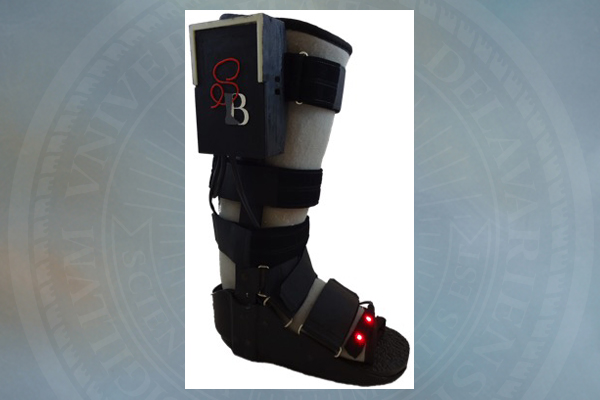Engineering students add high-tech function to low-tech orthopedic boot
If you’ve ever sprained an ankle or had a stress fracture in your foot or lower leg, you’ve probably worn an orthopedic walking boot.
The Velcro-strapped black devices are designed to force rest while allowing partial weight bearing.
While experts agree that this combination is the best route to recovery, questions remain: How much weight should be kept off an injured limb? For how long? And how do patients know whether they’re correctly following clinician’s recommendations about weight bearing?
Enter SmartBoot, which enables clinicians to monitor patient compliance during daily life and provides patients with visual feedback to let them know if they are under- or overloading their limbs after an injury.
Developed by an interdisciplinary engineering senior design team at the University of Delaware, SmartBoot recently received a third-place award at the 2015 Summer Biomechanics, Bioengineering and Biotransport Conference in Snowbird, Utah.
Undergraduates Melissa Groome, David Schnall, Michael Schenk, Meg O’Brien and Timothy West carried out the project for sponsors Jill Higginson, associate professor of mechanical engineering, and Brian Knarr, associate scientist in the Delaware Rehabilitation Institute.
“This device brings science to an established technique,” says Higginson. “Patients are often trained in the clinic on a bathroom scale and then sent home with crutches, with the assumption that they can consistently perform partial weight bearing on their own.”
However, recent research conducted by Higginson and Knarr has shown that patients often bear significantly more weight on the injured foot than prescribed, even immediately after training.
“New technology is enabling devices like SmartBoot to shed some quantitative scientific light on established treatment approaches,” Knarr says. “Sensors have become more affordable and smaller, allowing existing protocols to be turned into better tools for clinicians.”
Features incorporated into the boot include force sensors, data processing, data storage, wireless data transmission and sensory feedback.
“The results of our first prototype were very promising, but our force sensors weren’t accurate enough to provide any useful data, and the device was hard to modify overall due to the electrical wiring,” says West, a biomedical engineering major.
Although the senior design class was over at the end of the fall 2014 semester, the team continued to work on the boot to prepare for the conference with support from the College of Health Sciences First Step. They were able to implement some critical improvements, including new force sensors, better switches, detachable wiring and a rechargeable battery.
“In fact, nearly every aspect of the device changed in a positive way, and although we weren’t working for a grade anymore, the work was just as satisfying,” West says.
“The project gave me much more than a grade and a few awards,” he adds. “These senior design projects, especially the interdisciplinary ones, require us to develop critical communication and coordination skills as we combine our individual strengths to produce a device we can all be proud of.”
“I also pushed myself to develop technical skills I wouldn’t otherwise have — everything from 3-D printing to designing printed circuit boards and programming microprocessors. These skills helped me market my way to my first full-time job as a software test engineer, and I couldn’t be happier with where I’ve ended up.”
Progress continues on the SmartBoot this summer with two undergraduates working to take it to the next level.
The undergraduate team represented three branches of engineering: biomedical (West and Schnall), mechanical (Schenk and O’Brien), and electrical (Groome).
In addition to Knarr and Higginson, Dave Logerstedt, assistant professor of physical therapy, provided clinical input to the project.
“We wouldn’t have been able to complete this project without that mix of skillsets,” Knarr says.


